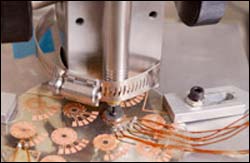Mini Generator Has Enough Power to Run Electronics

The microgenerator produces useful amounts of electricity by spinning a small magnet above a mesh of coils fabricated on a chip
New microengines would be smaller, last 10 times longer than batteries
It may be tiny, but a new microgenerator developed at Georgia Tech can now produce enough power to run a small electronic device, like a cell phone, and may soon be able to power a laptop. The microgenerator is about 10 millimeters wide, or about the size of a dime. When coupled with a similarly sized gas-fueled microturbine (or jet) engine, the system, called a microengine, has the potential to deliver more energy and last 10 times longer than a conventional battery.
Developed by doctoral candidate David Arnold, postdoctoral fellows Dr. Iulica Zana and Dr. Jin-Woo Park, and Professor Mark Allen, in the School of Electrical and Computer Engineering at Georgia Tech, the microgenerator produces useful amounts of electricity by spinning a small magnet above a mesh of coils fabricated on a chip. The microelectromechanical system (MEMS) was developed in close collaboration with Sauparna Das and Dr. Jeffrey Lang in the Department of Electrical Engineering and Computer Science at the Massachusetts Institute of Technology (MIT).
While work has been underway for several years on various microengine concepts, Georgia Tech’s generator has now demonstrated the ability to produce the wattage necessary to power an electronic device, Arnold said. “We can now get macro-scale power from a micro-scale device,” Arnold added. This advancement is a key step in microengines someday being incorporated into products and possibly replacing conventional batteries in certain electronics. “This is an important step in the development of MEMS-based micro-power systems,” Allen said.
The device’s magnet spins at 100,000 revolutions per minute (rpm), much faster than the comparatively sluggish 3,000 rpm of an average car engine. Speed like that is capable of producing 1.1 watts of power, or enough juice to run a cell phone. If the project reaches its projected goal, it will eventually produce as much as 20 to 50 watts, capable of powering a laptop.
The research is part of a larger project funded by the Army Research Laboratory to create lighter portable power sources to replace the heavy batteries that currently power a soldier’s equipment, such as laptops, radios, and GPS systems. Researchers at the University of Maryland and Clark Atlanta University also collaborate on the project.
One of the team’s key problems was figuring out how to spin the magnet fast enough to get useful amounts of power, while keeping the magnet from breaking apart. High-performance magnets are brittle and easily broken up by the centrifugal force created by high speeds. To overcome this problem, the researchers have optimized the magnet dimensions and encased it in a titanium alloy to increase its strength.
In the lab, the team used an air-powered drill — similar to what a dentist would use — that simulates the spinning of the magnet by the micro gas turbine (still under development at MIT). Now that initial tests have been successful, they hope to increase the speeds to what would be used in an actual microengine to squeeze out more power.
The Georgia Tech/MIT team will present their progress with the project at the International Conference on Micro Electro Mechanical Systems (MEMS) in January.
Media Contact
More Information:
http://www.gatech.eduAll latest news from the category: Power and Electrical Engineering
This topic covers issues related to energy generation, conversion, transportation and consumption and how the industry is addressing the challenge of energy efficiency in general.
innovations-report provides in-depth and informative reports and articles on subjects ranging from wind energy, fuel cell technology, solar energy, geothermal energy, petroleum, gas, nuclear engineering, alternative energy and energy efficiency to fusion, hydrogen and superconductor technologies.
Newest articles

Largest magnetic anisotropy of a molecule measured at BESSY II
At the Berlin synchrotron radiation source BESSY II, the largest magnetic anisotropy of a single molecule ever measured experimentally has been determined. The larger this anisotropy is, the better a…

Breaking boundaries: Researchers isolate quantum coherence in classical light systems
LSU quantum researchers uncover hidden quantum behaviors within classical light, which could make quantum technologies robust. Understanding the boundary between classical and quantum physics has long been a central question…

MRI-first strategy for prostate cancer detection proves to be safe
Active monitoring is a sufficiently safe option when prostate MRI findings are negative. There are several strategies for the early detection of prostate cancer. The first step is often a…



